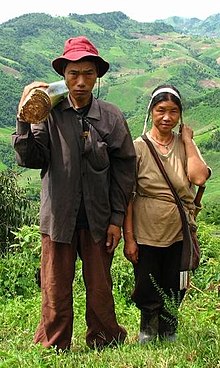Human
Species of hominid in the genus Homo / From Wikipedia, the free encyclopedia
Dear Wikiwand AI, let's keep it short by simply answering these key questions:
Can you list the top facts and stats about Human?
Summarize this article for a 10 years old
Humans, or modern humans (Homo sapiens), are the most common and widespread species of primate. A great ape characterized by their hairlessness, bipedalism, and high intelligence, humans have large brains, enabling more advanced cognitive skills that enable them to thrive and adapt in varied environments, and develop complex societies and civilizations. Humans are highly social and tend to live in complex social structures composed of many cooperating and competing groups, from families and kinship networks to political states. As such, social interactions between humans have established a wide variety of values, social norms, languages, and rituals, each of which bolsters human society. The desire to understand and influence phenomena has motivated humanity's development of science, technology, philosophy, mythology, religion, and other frameworks of knowledge. Humans also study themselves, through such domains as anthropology, social science, history, psychology, and medicine.
| Human[1] | |
|---|---|
 | |
| An adult human male (left) and female (right) (Thailand, 2007) | |
| Scientific classification | |
| Domain: | Eukaryota |
| Kingdom: | Animalia |
| Phylum: | Chordata |
| Class: | Mammalia |
| Order: | Primates |
| Suborder: | Haplorhini |
| Infraorder: | Simiiformes |
| Family: | Hominidae |
| Subfamily: | Homininae |
| Tribe: | Hominini |
| Genus: | Homo |
| Species: | H. sapiens |
| Binomial name | |
| Homo sapiens Linnaeus, 1758 | |
 | |
| Homo sapiens population density (2005) | |
Although some scientists equate the term "humans" with all members of the genus Homo, in common usage it generally refers to Homo sapiens, the only extant member. Other members of the genus Homo are known posthumously as archaic humans. Anatomically modern humans emerged around 300,000 years ago in Africa, evolving from Homo heidelbergensis or a similar species. Migrating out of Africa, they gradually replaced and interbred with local populations of archaic humans. For most of their history, humans were nomadic hunter-gatherers. Humans began exhibiting behavioral modernity about 160,000–60,000 years ago. The Neolithic Revolution, which began in Southwest Asia around 13,000 years ago (and separately in a few other places), saw the emergence of agriculture and permanent human settlement. As populations became larger and denser, forms of governance developed within and between communities, and a large number of civilizations have risen and fallen. Humans have continued to expand, with a global population of over 8 billion as of 2023[update].
Genes and the environment influence human biological variation in visible characteristics, physiology, disease susceptibility, mental abilities, body size, and life span. Though humans vary in many traits (such as genetic predispositions and physical features), any two humans are at least 99% genetically similar. Humans are sexually dimorphic: generally, males have greater body strength and females have a higher body fat percentage. At puberty, humans develop secondary sex characteristics. Females are capable of pregnancy, usually between puberty, at around 12 years old, and menopause, around the age of 50.
Humans are omnivorous, capable of consuming a wide variety of plant and animal material, and have used fire and other forms of heat to prepare and cook food since the time of Homo erectus. Humans can survive for up to eight weeks without food and several days without water. Humans are generally diurnal, sleeping on average seven to nine hours per day. Childbirth is dangerous, with a high risk of complications and death. Often, both the mother and the father provide care for their children, who are helpless at birth.
Humans have a large, highly developed, and complex prefrontal cortex, the region of the brain associated with higher cognition. Humans are highly intelligent, capable of episodic memory, have flexible facial expressions, self-awareness, and a theory of mind. The human mind is capable of introspection, private thought, imagination, volition, and forming views on existence. This has allowed great technological advancements and complex tool development to be possible through complex reasoning and the transmission of knowledge to subsequent generations. Language, art, and trade are defining characteristics of humans. Long-distance trade routes might have led to cultural explosions and resource distribution that gave humans an advantage over other similar species.